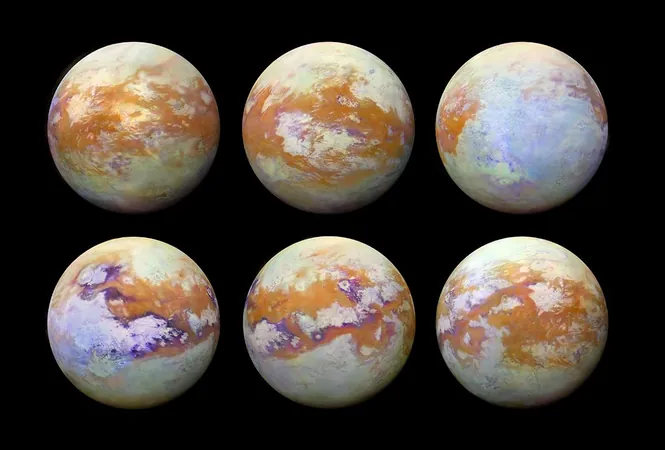
Could Titan’s Alien Lakes Be Hosting the Building Blocks of Life?
2025-07-16
Author: Emily
The Search for Life Beyond Earth
Could Titan, Saturn's largest moon, be the next frontier in the quest for extraterrestrial life? This fascinating moon stands out in our Solar System as the only celestial body, aside from Earth, known to have liquid on its surface.
However, these aren't the typical water bodies we find on Earth. Titan's lakes and rivers are filled with liquid hydrocarbons, primarily methane and ethane, creating a unique environment that raises intriguing questions about life beyond Earth.
The Science Behind Titan’s Chemistry
Recent research has suggested that these hydrocarbon-rich lakes might harbor something remarkable: cell-like structures, known as vesicles, that could naturally form in Titan's frigid embrace. A study published in the *International Journal of Astrobiology* posits that this process could mirror the early conditions that led to the origin of life on our own planet.
Life’s Origins: A Connection to Titan?
On Earth, life is believed to have begun in a primordial mix of organic molecules organized into vesicles—tiny compartments created by amphiphiles, molecules with both water-hating and water-loving ends. In suitable conditions, these amphiphiles form protective bubbles, reminiscent of the cell membranes we have today.
But with Titan’s average surface temperature plummeting to around -290°F (-179°C), can these vesicles still form? Scientists have been investigating this very question.
Vesicles in the Methane Abyss
Researchers explored Titan’s unique atmosphere and chemical makeup, theorizing that vesicles could potentially assemble in liquid methane or ethane. It’s hypothesized that sea spray droplets, created by the impact of rainfall, might be coated with amphiphiles. When these droplets land back on Titan’s hydrocarbon lakes, they could form double-layered membranes that encase them like tiny, primordial cells.
While these vesicles wouldn’t be alive, they might serve as protocells—primitive structures that concentrate and protect organic molecules, seen as vital steps towards the emergence of life.
Titan: A Chemistry Lab in the Sky
NASA’s Cassini spacecraft has provided essential data revealing Titan’s rich nitrogen and methane atmosphere, with a dynamic weather system that includes methane clouds, rain, rivers, and lakes. This cycle of evaporation and precipitation may replicate early Earth conditions, breaking down simple molecules into complex organics that could rain down into the lakes.
According to Conor Nixon from NASA’s Goddard Space Flight Center, the potential existence of vesicles on Titan would indicate an increase in molecular complexity—an essential factor for the origin of life. Nixon states, 'We’re excited about these new ideas because they can open up new directions in Titan research and may change how we search for life on Titan in the future.'
The Future: Dragonfly Mission Awaits!
NASA's upcoming Dragonfly mission, set to launch later this decade, aims to unlock more of Titan's mysteries. This innovative drone-like rotorcraft won’t directly explore Titan’s lakes or be equipped to search for vesicles. Instead, it will hop across varied landscapes, analyzing the intricate chemistry of dunes, craters, and icy plains.
With close-up examinations of Titan's surface and atmosphere, Dragonfly could illuminate whether the essential precursors for life are indeed forming on this enigmatic moon.









 Brasil (PT)
Brasil (PT)
 Canada (EN)
Canada (EN)
 Chile (ES)
Chile (ES)
 Česko (CS)
Česko (CS)
 대한민국 (KO)
대한민국 (KO)
 España (ES)
España (ES)
 France (FR)
France (FR)
 Hong Kong (EN)
Hong Kong (EN)
 Italia (IT)
Italia (IT)
 日本 (JA)
日本 (JA)
 Magyarország (HU)
Magyarország (HU)
 Norge (NO)
Norge (NO)
 Polska (PL)
Polska (PL)
 Schweiz (DE)
Schweiz (DE)
 Singapore (EN)
Singapore (EN)
 Sverige (SV)
Sverige (SV)
 Suomi (FI)
Suomi (FI)
 Türkiye (TR)
Türkiye (TR)
 الإمارات العربية المتحدة (AR)
الإمارات العربية المتحدة (AR)